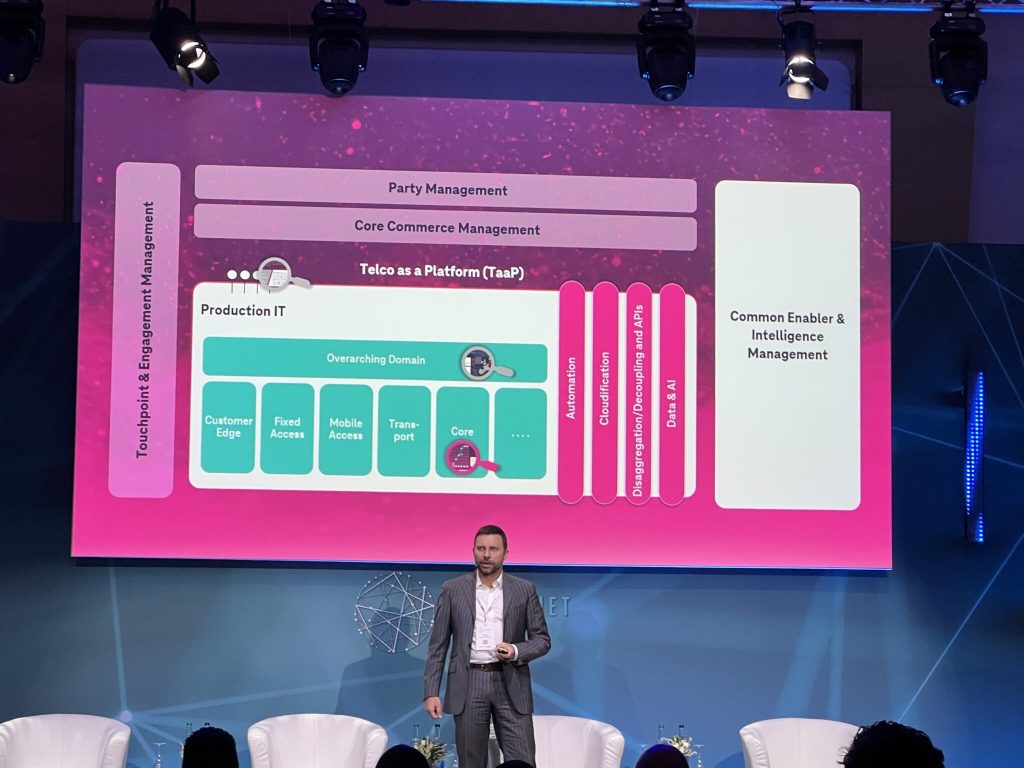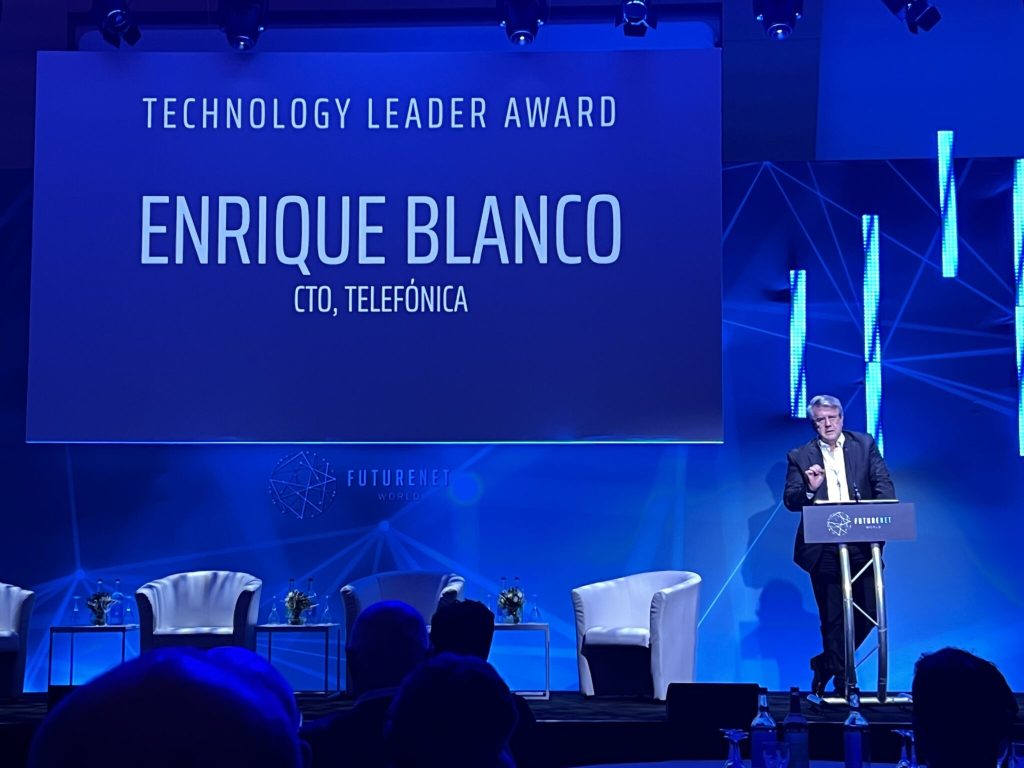I blame Neil McRae.
If, as a 15-year-old he hadn’t given a future tech giant a point-by-point rundown of the shortcomings of his company’s development platform, the course of IT – and thereby Telecom – history might have been very different.
We might have believed that low-to-zero growth was a reasonable ambition. That innovation meant engineers working in rarefied labs on long-range projects, rather than addressing the needs of today’s customers. Or that the whole business of telecom was somehow too special for its very foundations to be rocked.
But that’s not how things are panning out. Such beliefs are not the future of telecom, an industry which is now more fundamentally intertwined than ever with our personal, social, corporate, economic and environmental progress.
The good news is that on the basis of FutureNet World 2023, telecom might just be getting it. Far greater automation and intelligence are essential and fundamental, even if technology is only one component of the way forward. There is a greater urgency in the air, and perhaps even a better sense of the sheer scale of the opportunities ahead. FutureNet World 2023 was an excellent window into current industry thinking and progress.
Kicking Off
The opening panel was pretty lively, with the people truly responsible for networks sharing some home truths, as well as acknowledging achievements.
Scott Petty, CTO at Vodafone, Greg McCall (Chief Networks Office) and Enrique Blanco (CTIO, Telefonica) were all pretty frank about the state of telecom. It is not the most well-liked sector (for consumers or investors), and its very success in providing resilient massive scale connectivity, has led to it being somewhat taken for granted. Nonetheless, telecom is under-fulfilling its potential. In hard economic terms, it’s not making decent returns for investors, and the future looks worse – unless we get serious about change.
There was a mood that telco does need to change and must look to new relationships and ways of working. Perhaps that is only to be expected at a conference on Automation, but this sample of telecom CxOs seems at least to be speaking with increased urgency. Certainly, these operators see a radically different future for their companies, specifically as software and solutions companies.
“All of us will become software organizations”
Ciena’s Joe Cumello referenced the 200+ projects that Blue Planet has gobally, and the need for more than just technology. The people and project skills – especially the ability to work with in cross-silo collaboration – are essential.
Vodafone commented that while telco had been keen on outsourcing, in a software era that model wouldn’t work. The pace of change, and the opportunities that brings, mean that telcos need to build up their own software skills. All speakers agreed that technology is not the problem, with BT talking about a new cadre of “netware people” with both network and IT skills.
“Let’s not fight over the crumbs, but [partner to] make a bigger cake” – Vodafone’s Andrea Dona, on the purpose of partnerships.
Enrique Blanco stressed the need for strong partnerships with common purpose – sustainability, autonomation top of the list.
Cumello emphasized the need for not-just-technology solutions. That goes all the way to how budget is allocated, who owns it, and the need for a new level of co-ordinating and coherence in how projects are initiated and managed. Network, IP and Ops are increasingly interdependent stakeholders – people! – and any talk of transformation must involve all three.
The real challenge today is brownfield, since that is where most people work, most of the network is, and most of the spend. Cumello summed up with “the future is now”, calling for telcos to accept that working practices of the last 20 years are essentially end-of-life.
Slicing
Not for the first time at a telecom conference, network slicing once again received a rather mixed reception.
Like Swisscom, BT’s Principal Network Strategist, Viraj Abhayawardhana, articulated a strategy based on delivering customers the best experience not necessarily the first. Could the priority given to “time-to-market” be giving way to a “best-to-market”? Or is this just a spin on CSP lack of ambition?
Undeterred, Colt’s Aaron Partouche talked about the need for an intelligent digital infrastructure and slicing as a “key pillar” of its strategy, though with closed-loop automation yet to be implemented.
Slicing continues to be accompanied by a large question mark, as operators struggle to figure out how to make a viable business model out of many niche requirements.
NaaS
Industry discussion on Network-as-a-Service (NaaS) continues to be somewhat muddled. Speakers from Colt, Swisscom and Itential did their best, but beyond the most basic of principles, the conversation diverges.
“On-demand” isn’t necessarily “Network-as-a-Service”. Nor are Network APIs. Johanne Mayer, the TM Forum’s transformation lead, commented “true NaaS means taking things out of current IT systems (i.e. BSS).” She went a step further: “a product that is defined in the BSS is a problem”. Such de-layering is a vision that Telenor seems all in on.
“Legacy network is a limiting factor” in achieving speed, said Ruza Sabanovic, EVP and Chief Technology Officer, Telenor. (Via its JV with Cisco, Telenor spin-out Working Group Two is offering a 100% cloud-based mobile core to support MVNOs).
“The integrated model for supporting enterprises is dead, disaggregated platforms are the future.”
Telenor is clearly in the Open camp and wants the global industry to get on board.
If it is to mean anything, then NaaS must be about more than simply exposing network APIs. There are a host of operational and commercial considerations needed, and at the end of it all, the need to make it profitable. What is also clear is that automation once again rises to the top – NaaS without automation makes no sense.
5G SA
5G SA is lagging. A lack of compatible devices, “suboptimal” CNFs (according to Vodafone’s Andrea Dona), and a missing killer use case are all dampening enthusiasm from telcos. Even if broadcasting is all up for it (Vodafone recently made a splash about the use of its 5G SA to carry TV from the coronation of King Charles III).
Dona admitted that the resources required for OSS transformation that 5G SA requires just haven’t been there, but that managing the transition to cloud-native will be the difference between winners and also-rans.
In enterprise, 5G SA is seeing lots of pilots, but the question is whether telcos will be able to scale multiples of these up into a meaningful (and profitable!) line of business.
Swisscom, a noted pioneer, has been intentionally cautious on 5G SA. As Mark Duessner, EVP of Mobile put it, “the market is not demanding [its] features”, buying more time for the operator to plan an eventual transition. It is not the benefits of 5G that are in question, but the benefits relative to 4G. Fundamentally, the NSA to SA is characterized by a shift from virtual network functions to fully containerized.
BT Digital’s Chief Architect Josie Smith added a welcome perspective to the event, reminding attendees and panelists that between a network API and the customer is an applications team whose primary question is not “How can I use this?” but “what is this going to do for customers?” Even within a single telco, the internal supply chain is changing. It’s all very well to imagine 5G SA applications, but there is no substitute for living enterprise customers’ experience. She also referred to progress in applying DevSecOps in BSS, but urged operators to take AIOps down into the network domain, citing BT’s partnership with ServiceNow Dynatrace as a source of learnings.
Michal Patryk Debickji from Reailize (a B-yond company) called out that today’s 5G had been deployed “like 4G”, with key new components (such as NWDAF) specifically left out because of their unfamiliarity to Ops teams.
Telco as a Platform
Deutsche Telekom’s Thomas van Briel (SVP Architecture & Strategy) explained DT’s Telco as a Platform (TaaP) vision, and how just a year ago (!) the company had reset its course to become a “leading digital telco”, fully embracing the TM Forum’s Open Digital Architecture. A pan-European Digital NOC is now resolving 70% of trouble tickets automatically and has cut truck rolls by 15%.

Thomas van Briel explains Deutsche Telekom’s Telco-as-a-Platform Strategy
160 Network Functions (40%) have been cloudified, with a that number expected to be almost 75% in 2025.
“Infrastructure should be seen as a commodity, not a differentiator”.
DT adopts a multi-cloud strategy, using hyperscalers where it makes sense. As Thomas put it: infrastructure is not a differentiator. On the other hand, automation certainly can be a differentiator, especially when it can be reused across any cloud-native network function. DT has a set of twelve key criteria from Orchestratability (my word) to license model that it uses to qualify network functions.
Thomas was one of many speakers to reference CAMARA, which will see DT put three of that initiative’s 20 APIs into commercial availability during 2023.
He signed off by commenting that it is more important to equip current teams with digital skills than seek new hires.
Open…for Business
Telus’ CTO Ibrahim Gedeon was frank about the cost of embracing openness. MTN’s Group CIO Nikos Angelopoulos was likewise sober about the industry’s progress in delivering the benefits of fully open networks. Basak Fouladi, CTO for KPN, also highlighted the gap between a decade of talking open and seeing it benefit telcos on a global scale.
Yet all were clear that open-ness is vital to greater speed. Amdocs’ Niall Norton sensed an “urgency shift”. It made for a lively discussion (“5G NSA is a travesty!” said Gedeon).
Awards
FutureNet World’s awards offer more signs for optimism over mere wishful thinking. It is good that large vendors feature in FutureNet World’s shortlists, and among the winners. By definition, their improvements have the greatest potential to affect the industry. But it is also good to see that they are not the only companies with automation successes to shout about: Cohere Technologies, Inmanta (a winner this year) demonstrate that operators should remain open-minded, and that no vendor has a monopoly on innovation.
Awards went to:
- Best Automation Deployment – China Mobile, with Huawei.
- Best Automation Solution – Netcracker for Network Domain Orchestration.
- Best Network Disaggregation Award – Rakuten Symphony/Mobile for cloud-native Open RAN.
- Most Innovative AI for Customer Experience – VMWare, with Network Scorecard rApp using the VMware RIC.
- Best Orchestration Award – Inmanta, for Mobile Private Networks solution
- Best AIOps Solution – Nokia, with BT for Homeview
- Sustainability Award – Ericsson, for their Predictive Cell Energy Management solution.
The Technology Leadership for Enrique Blanco is fully deserved and was very graciously accepted. His call to “continuously learn” should be seen as a challenge to us all, more than an explanation of his own achievements.

Enrique Blanco Receives the Technology Leadership Award
Wrapping Up
Neil McRae closed the event with passion and not a little provocation. If his presentation made for uncomfortable listening, so much the better. Home truths are what an industry in search of its future needs.
To summarize a lively Q&A, the biggest threat that telecom faces is believing that DNA-level change is a bigger risk than maintaining the current way of working. (Yes, read that again). The challenges that telecom can – and should – help to solve range from personal to truly global, and everything in between.
My takeaway from the event was that six ‘Ps’ now are now shaping telecom automation strategies. They are: Programmability, Profitability, Platforms, People, Partnerships, and Planet. All six were strong themes at FutureNetWorld 2023.
The five-year-old FutureNet World conference series, free from legacy and excess baggage that other conferences may carry, provides the perfect and thoroughly professional forum for the industry to air, and rise to, this unique opportunity.
Next year’s FutureNet World will be at the later date of 1-2 October.
Listen to Robert Curran and Francis Haysom’s post-show discussion on FutureNet World and RCR Wireless Live! in the Appledore Podcast.